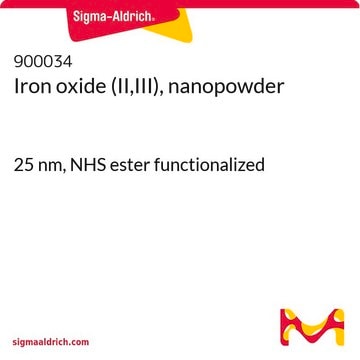As mentioned in the 'PROPERTIES' section above, this material as an estimated surface area of 6-8 m2/g.
637106
Iron(II,III) oxide
nanopowder, 50-100 nm particle size (SEM), 97% trace metals basis
Synonym(s):
Ferrosoferric oxide, Iron oxide black, Magnetite
Select a Size
Select a Size
About This Item
Recommended Products
Quality Level
Assay
97% trace metals basis
form
nanopowder
spherical
surface area
6-8 m2/g , estimated
particle size
50-100 nm (SEM)
mp
1538 °C (lit.)
density
4.8-5.1 g/mL at 25 °C (lit.)
bulk density
0.84 g/mL
application(s)
battery manufacturing
SMILES string
O=[Fe].O=[Fe]O[Fe]=O
InChI
1S/3Fe.4O
InChI key
SZVJSHCCFOBDDC-UHFFFAOYSA-N
Looking for similar products? Visit Product Comparison Guide
General description
Application
Analysis Note
Storage Class Code
11 - Combustible Solids
WGK
nwg
Flash Point(F)
Not applicable
Flash Point(C)
Not applicable
Personal Protective Equipment
Choose from one of the most recent versions:
Certificates of Analysis (COA)
Don't see the Right Version?
If you require a particular version, you can look up a specific certificate by the Lot or Batch number.
Already Own This Product?
Find documentation for the products that you have recently purchased in the Document Library.
Customers Also Viewed
Articles
Prof. Randal Lee discusses iron oxide magnetic nanospheres and nanocubes design considerations for biosensing applications.
Magnetic nanoparticles have attracted tremendous attention due to their novel properties and their potential applications in magnetic recording, magnetic energy storage and biomedicine.
An article concerning self-propagating reactions induced by mechanical alloying, presented by Sigma-Aldrich.com.
Graphene is a unique two-dimensional (2D) structure of monolayer carbon atoms packed into a dense honeycomb crystal that has attracted great interest due to its diverse and fascinating properties.
-
What is the specific surface area of product 637106 Iron (II,III) oxide ?
1 answer-
Helpful?
-
-
How can I determine the shelf life / expiration / retest date of this product?
1 answer-
If this product has an expiration or retest date, it will be shown on the Certificate of Analysis (COA, CofA). If there is no retest or expiration date listed on the product's COA, we do not have suitable stability data to determine a shelf life. For these products, the only date on the COA will be the release date; a retest, expiration, or use-by-date will not be displayed.
For all products, we recommend handling per defined conditions as printed in our product literature and website product descriptions. We recommend that products should be routinely inspected by customers to ensure they perform as expected.
For products without retest or expiration dates, our standard warranty of 1 year from the date of shipment is applicable.
For more information, please refer to the Product Dating Information document: https://www.sigmaaldrich.com/deepweb/assets/sigmaaldrich/marketing/global/documents/449/386/product-dating-information-mk.pdfHelpful?
-
-
How is shipping temperature determined? And how is it related to the product storage temperature?
1 answer-
Products may be shipped at a different temperature than the recommended long-term storage temperature. If the product quality is sensitive to short-term exposure to conditions other than the recommended long-term storage, it will be shipped on wet or dry-ice. If the product quality is NOT affected by short-term exposure to conditions other than the recommended long-term storage, it will be shipped at ambient temperature. As shipping routes are configured for minimum transit times, shipping at ambient temperature helps control shipping costs for our customers. For more information, please refer to the Storage and Transport Conditions document: https://www.sigmaaldrich.com/deepweb/assets/sigmaaldrich/marketing/global/documents/316/622/storage-transport-conditions-mk.pdf
Helpful?
-
-
what is the Iron concentration in ug/ul of Product 637106?
1 answer-
This product is in powder form. The density is 4.8-5.1 g/mL at 25 °C (lit.), with an average of 4.95 g/mL. The iron content is tested on a lot-to-lot basis. For lot# MKCV7594, the iron content is 66.5%, and the purity is 97%. Therefore, the iron concentration is calculated as 4.95 x 66.5% x 97% = 3.19 g/mL = 3190 µg/µL.
Helpful?
-
-
Does this product have paramagnetic properties?
1 answer-
The paramagnetic properties of this product have not been determined.
Helpful?
-
-
How can the nanopowder Iron(II,III) oxide, Product 637106, be dispersed in an aqueous solution?
1 answer-
1. It is recommended to use a neutral buffered solution (approximately pH 7). The pH of the solution is an important factor in achieving a monodispersion of the nanopowder.2. Probe-type ultrasonication is strongly recommended by the manufacturer.3. If the material is not well dispersed by ultrasonication in a neutral buffer, add a surfactant. This will wet the nanoparticle surface. Since the particles are small (less than 50 nm), they have a high surface area to volume ratio. They can therefore absorb gases such as oxygen or carbon dioxide from the air, which would decrease the dispersity of the particles. Degassing the buffer before use may help to eliminate the formation of gas bubbles.
Helpful?
-
-
What is the Department of Transportation shipping information for this product?
1 answer-
Transportation information can be found in Section 14 of the product's (M)SDS.To access the shipping information for this material, use the link on the product detail page for the product.
Helpful?
-
-
What is the particle sizeof Product 637106, Iron(II,III) oxide?
1 answer-
Average particle sizes are 50-100 nm.
Helpful?
-
-
Is Product 637106, Iron(II,III) oxide, stabilized (coated)?
1 answer-
No, product 637106 has not been coated on the surface per the supplier.
Helpful?
-
Active Filters
Our team of scientists has experience in all areas of research including Life Science, Material Science, Chemical Synthesis, Chromatography, Analytical and many others.
Contact Technical Service






